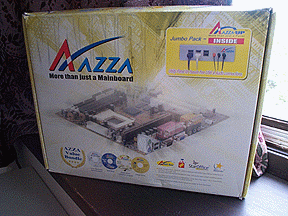Specifications and afterthoughts
| Azza 633X-AD | |
| Supported CPUs | Intel Pentium III (up to 1GHz)/ Celeron FC-PGA (up to 900MHz+) |
| CPU socket | Socket-370 (PPGA/FC-PGA) |
| System bus | 66/100/133MHz SDR |
| Chipset | VIA Apollo Pro266 |
| Supported FSBs | 66-166MHz |
| Overclocking features |
|
| Memory | Three 184 pin DIMM slots supporting max. 1.5GB DDR SDRAM |
| Expansion slots (AGP/ PCI/ ISA/ AMR|CNR) | 1/5/0/1 |
| USB ports | 6 USB 1.1 |
| Integrated VGA | None |
| Integrated sound | AC'97 soft CODEC supporting Dolby Digital (AC-3) 5.1 decoding |
| Other features | Azza-UP front panel, Mandrake Linux, StarOffice, VirtualDrive |
| BIOS | Award BIOS v6.00.PG |
| Dimensions | ATX, 304x235mm |
| Related online material | "Azza.com", BIOS, manual (PDF) |
Now our usual comments on the chart: the first thing that we notice is that our long-awaited Dolby Digital sound-chip is not exactly what we were thinking about. To put it simple, it is software based and thus consumes the system's resources seriously, it does not offer a digital output (S/PDIF Out) and what's more it simply sounds horrible. It might be a nice thing for system integrators because they can include it on the checklist and it was definitely enough for us to get tricked into wanting this board, but all-in-all, you should not be looking into this feature unless you want your shiny new 1.33GHz Athlon to perform below the neighbour's 750MHz Duron when playing music. Luckily, this is about where the negative critics end, since apart from this little "nuissance", the board was simply superb.
Booting is FAST! I had to reset 4 times before I could hit F8 before the Windows boot. I simply wasn't fast enough :). The BIOS Setup is organized in a way we have never thought it was possible. ALL manufacturers could and should learn from Azza on this one. Everything is where it should be, information/settings are well divided into subsections and you are allowed to control everything if you dig deep enough. Apart from the booting process, Pro Team itself was also fast, as when we requested them for a new beta BIOS (we were having some awkward problems, but they later turned out to be unrelated to the board), they sent it as soon as there was one. Kind of a cool thing to flash the BIOS and see that its compilation date is TODAY :)). The new BIOS added the option of enabling the BIOS for the onboard LAN chip, which unfortunately didn't have its connector and thus couldn't be tested (onboard LAN, Sound and Modem are all functions of the VIA sets, with LAN and Modem integrated into the South-Bridge and a separate VIA chip driving the Sound). The RAM Timing settings also received 3 new options and what a wise decision that was! You will see from later benchmarks that tuning these three settings yielded a 10 percent memory boost, alone.

The board also has a little red light that only turns on, when the system has been shut down but is under power (+5V). Whenever you see the red light, don't touch the board! We assume that one can recognize a running system and thus do not need lights to show that the computer is on (just listen to the Earthquake-like shake/sound those FOP38's produce and you can't go wrong... :))). This is actually a feature of ATX which we aren't very fond of. It is useful for WOL (Wake-Up on LAN) and other automatic wake up methods, but is not really useful when you truly want to turn the system off. So, before installing your second AGP GeForce3 board into the 633X-AD :), make sure you pull the plug.
Stability: unarguably the most important feature of a motherboard. This was the biggest question we had in mind, but the 633X-AD didn't dissapoint, at all. It actually allowed us to run our Celeron 566MHz FC-PGA CPU a tad higher than what we could achieve with MSI's 815EP Pro-R. In the long run, both boards were rock stable at a 112MHz FSB (resulting in 8.5 x 113 = 952MHz... not bad for a 566MHz chip (1.7V, cC0 stepping)) and that puts the Azza board right on par with MSI's offering (MSI also has a Pro266 board, better said a lot of Pro266/Pro266T boards). Before we move on to our regular Sandra memory benchmarks, I would like to point out that the 633X-AD does not support Intel's freshly released Tualatin CPU (officially known as Pentium III-S) as it is based on the Pro266 and not the Pro266T chipset. But expect Azza to release such a board just like other manufacturers do.
A cikk még nem ért véget, kérlek, lapozz!








